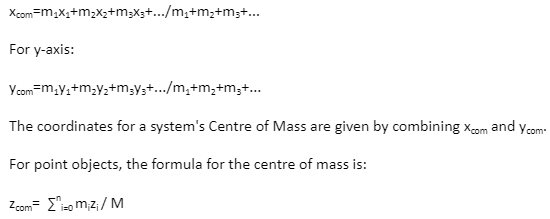Every physical system has a single point whose motion defines the motion of the whole system. When the system is subjected to an external force, this point moves as if the system’s whole mass were concentrated at it, and the external force was likewise applied to it. As a result, this place is referred to as the system’s ‘centre of mass.’ A system’s motion may be characterised in terms of its centre of mass’s motion.
Centre of Mass
The Centre of Mass of an object is a place specified relative to an item or a system of objects. The Centre of Mass is defined as the average location of all pieces of a system that are weighted according to their Masses.
The centre of mass is a place that is related to an item in basic terms. It is the mean location of mass distribution in space, or it is the average position of all the pieces of the system. It’s a point when force is normally applied to produce linear acceleration rather than rotational acceleration.
We don’t need to worry about the dynamics of individual particles of the system while examining the dynamics of the motion of the system as a whole. However, simply concentrate on the dynamics of a single point that corresponds to that system.
Importance
A system’s Centre of Mass is the place on the object where any uniform force is applied. Finding the Centre of Mass of items is significant because it simplifies the solution of Mechanics issues that explain the motion of intricate and irregularly shaped objects. We assume that all of the Mass of an oddly-shaped item is concentrated in a tiny object located at the Centre of Mass and that this little object is known as the point mass while completing computations.
The Centre of Mass of a system is calculated by adding the weighted position vectors pointing toward its Centre of Mass. For each axis, the Centre of Mass is determined independently. To calculate the x-axis, use the following formula:
For x-axis:

Centre of Gravity
The centre of gravity is the place at which the gravitational force operates on an item or system. It’s essentially the point at which the torque caused by gravitational forces vanishes. The centre of gravity and the centre of mass will be the same in circumstances when the gravitational field is believed to be uniform. Because they are frequently claimed to be in the same position or place, these two phrases – centre of gravity and centre of mass – are sometimes used interchangeably.
System of Particles
A large number of atoms or molecules make up a “macroscopic” system, which is an ordinary-sized item. Trying to characterise each particle in such a system independently using the rules we outlined for a single particle is impossible. Nonetheless, there are certain very simple characteristics of a macroscopic system’s behaviour that (as we’ll explain) obey the fundamental principles of particle behaviour. We’ll be able to show that each of the mechanical quantities important to the state of a multi-particle system has two parts:
- One part treats the system as if it were a single particle with its centre of mass at a certain location. The CM motion is what this section is known as.
- Another part describes the system’s internal motion as viewed through the eyes of an observer at the centre of mass.
Simply put, a well-defined collection of entities that may or may not connect with one another or are related to one another is referred to as a system of particles. They might be genuine particles in the translational motion of stiff things. Interacting particles exert force on one another.
These internal pressures always exist in opposing directions and in pairs of equal size. External forces may operate on all or portions of the particles, in addition to internal forces. A force exerted on any one particle included in the system by some other entity outside the system is referred to as an external force in this context.
Conclusion
On the whole, when force is applied to the centre of mass, the item as a system of particles travels in the force’s direction without spinning. The centre of mass, regardless of the object’s form, aids in understanding the object’s force and motion mechanisms.
 Profile
Profile Settings
Settings Refer your friends
Refer your friends Sign out
Sign out






